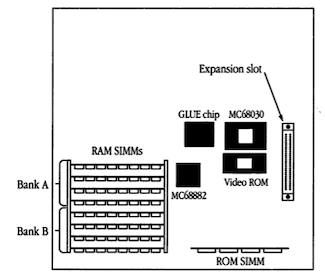Macintosh SE/30 ROM
< Back to homeTable of Contents
Summary
| ROM Access Rate | 15.67 MB/sec |
| ROM SIMM pins | 64 |
| ROM size | 256K (Expandable to 2MB) |
| Socketed? | Yes |
| Contents | Startup Chime, Happy Mac/Sad Mac icons, Macintosh Toolbox, Color QuickDraw, Slot Manager, other OS routines |
SE/30 ROM Technical Notes
ROM is the Macintosh computer's permanent read-onl memory. Its base address is available as the constant romStart and is also stored in the global variable ROMBase.
ROM contains the routines for the Macintosh Toolbox and Operating System, plus the various system traps. Because ROM access cycles are not interleaved with video or sound, the processor in a Macintosh computer can always access ROM at the same rate.
The ROM access rate for the Macintosh SE/30 is 15.67 MB/sec, the same as the Macintosh IIx and IIcx. This compares with an access rate of 3.92 MB/sec on the SE, 20 MB/sec on the IIci and 64 MB/sec on the IIfx.
The Macintosh SE/30 ROM is identical to that of the Macintosh IIx; it includes Color QuickDraw, the Slot Manager, and other features of the IIx ROM. It is composed of four 512 Kbit ROMs, for a total of 256K, and it is mounted on one ROM SIMM (ROM SIMMs are expandable to 2 MB). It is installed as a 64-bit ROM SIMM in a socket on the logic board. The slot makes it easy to upgrade the ROM.
System Software 6.0.3 (and later) patches to the ROM affect the Start Manager, the OS utilities, and the Sony driver.
The SE/30 ROM is interchangeable with ROMs from the Macintosh IIx, IIfx, and IIcx models. Generally speaking, the SE/30's architecture has more in common with the Macintosh II family than it does with its predecessor, the SE.

SIMM socket pinout diagram

Signal assigments for the ROM SIMM socket
|
|
24-bit "dirty" ROM
The Macintosh SE/30 shipped with a 24-bit ROM, often referred to as a 'dirty' ROM. The 24-bit ROM means acted as a bottleneck in the system, limiting the amount of memory which can be addressed to 8MB. This can be corrected either through software, or by replacing the ROM SIMM itself with a 32-bit 'clean' version.
Thankfully, the SE/30 was not significantly bottlenecked in any other manner.
Originally, this wasn't much of a problem because 1) System 6 did not support 32-bit addressing and 2) A lot of people wouldn't be planning on upgrading beyond 8MB, in fact at the time of the original launch of the SE/30, SIMMS larger than 1MB were not very common yet. And they cost a lot to purchase.
The SE/30 was not the only machine affected by the dirty ROM. Other affected machines include the Macintosh II, Macintosh IIx and Macintosh IIcx.
MODE32
A solution came in June 1991 with the release of a software product called MODE32 from Connectix, the same company that brought us Virtual and Maxima. At first, this was a proprietary product which cost $169 and came on a single floppy disk.
No doubt MODE32 was welcomed with warm arms, but it wasnt long before Apple licensed it and offered it free of charge to customers.
Modified/Upgraded ROMs
Third party ROMs are available which utilise the full 2MB ROM space and add support for things that were missing from the stock SE30/IIx ROM.
BMOW ROM-inator II
BMOW's ROM-inator II SIMM for the SE/30 adds HD-20 support, is 32-bit clean, and includes a bootable ROM disk, so it is well worth considering. It means your SE/30 can operate a Floppy Emu (which requires HD-20 support), and the bootable ROM disk also comes in handy when performing troubleshooting.
The power-on RAM test is disabled in the pre-programmed ROM. This speeds up boot times on Macs with 16 MB or more of RAM, skipping a time-consuming check that can take up to 1 minute otherwise.
Earlier ROM-inator IIs were produced on a PCB that is slightly too thin to sit tightly enough in the SE/30's ROMM SIMM slot. Rubber bands or hot glue are possible remedies, but neither were reliable enough when I tested these methods. The SE/30 is particularly stubborn when it comes to its ROM SIMM slot - the ROM SIMM must be tightly seated in the slot, otherwise a successful boot is not possible.
NEW: However, a later revision of the ROM-inator II is now produced on a thicker PCB which sits better within the SE/30's ROM slot. Thanks to our reader Dan for this tip!
GGLabs MacSIMM
The MacSIMM by GGLabs is a programmable SIMM compatible with the SE/30, IIfx and IIsi. These are produced on the correct thickness PCB meaning they fit correctly in the SE/30's ROM SIMM slot, unlike earlier revisions of the ROM-inator II. Using the IIsi ROM adds back the support for the HD20 which is not present in the stock SE/30 ROM.
References
- Guide to Macintosh Family Hardware, 2nd Edition (1990). Pages 231-238.
- TidBITS
- Apple Technical Note HW14: Macintosh SE/30 Info [Apr 1 1989]